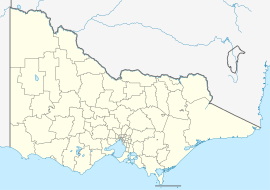Bunyip, Victoria
|
Bunyip Victoria |
|||||||||||||
|---|---|---|---|---|---|---|---|---|---|---|---|---|---|

Main Street
|
|||||||||||||
| Coordinates | 38°05′S 145°43′E / 38.083°S 145.717°ECoordinates: 38°05′S 145°43′E / 38.083°S 145.717°E | ||||||||||||
| Population | 2,232 (2011 census) | ||||||||||||
| Postcode(s) | 3815 | ||||||||||||
| Elevation | 85 m (279 ft) | ||||||||||||
| Location | |||||||||||||
| LGA(s) | Shire of Cardinia | ||||||||||||
| State electorate(s) | Narracan | ||||||||||||
| Federal Division(s) | McMillan | ||||||||||||
|
|||||||||||||
Bunyip is a town in Gippsland, Victoria, Australia, 82 km southeast of the Melbourne City Centre. Its local government area is the Shire of Cardinia and its major road connection is via the Princes Highway. At the 2011 Census, Bunyip had a population of 2,232.
The town is named after a mythical creature, known as the Bunyip or Bunyeep, which according to legend lived in and around swampy areas. Mention of it is often found in Australian and Aboriginal mythology.
The Koo-Wee-Rup and Bunyip areas, among others, are considered to be places of importance to the Victorian Aborigines, particularly the Bunurong people of the Kulin nation, the traditional owners of the area, from whom the word Bunyeep is derived. They believe the Bunyip is a spiritual being which lives near water and preys on humans who come too near.
The Kooweerup Swamp comprised a region of some 6,000 acres (24 km2) stretching from Sawtells Inlet on Westernport Bay to the township of Bunyip in the north-east. The marsh like area was formed by the waters of the many rivers which flow down from the surrounding high country and which often created impenetrable swamplands.
The first settlers had great difficulty in cultivating the land because of the dense stands of giant Melaleuca, or tea-tree, large Eucalyptus and Acacia melanoxylon, or blackwood trees, which lay under the surface. In 1827 William Hovell attempted to cross the swamp but found the scrub to be an impenetrable wilderness. He was impressed by the country, and those areas which were workable held some promise for future development.
...
Wikipedia

